Related Research Articles

The Arabian Peninsula, or Arabia, is a peninsula in West Asia, situated northeast of Africa on the Arabian Plate. At 3,237,500 km2 (1,250,000 sq mi), comparable in size to India, the Arabian Peninsula is the largest peninsula in the world.
The McMahon–Hussein Correspondence is a series of letters that were exchanged during World War I in which the Government of the United Kingdom agreed to recognize Arab independence in a large region after the war in exchange for the Sharif of Mecca launching the Arab Revolt against the Ottoman Empire. The correspondence had a significant influence on Middle Eastern history during and after the war; a dispute over Palestine continued thereafter.
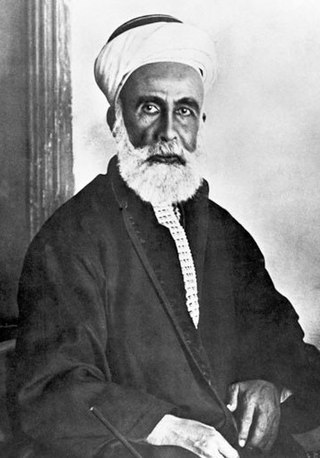
Hussein bin Ali al-Hashimi was an Arab leader from the Banu Qatadah branch of the Banu Hashim clan who was the Sharif and Emir of Mecca from 1908 and, after proclaiming the Great Arab Revolt against the Ottoman Empire, King of the Hejaz, even if he refused this title, from 1916 to 1924. He proclaimed himself Caliph after the abolition of the Ottoman Caliphate in 1924 and stayed in power until 1925 when Hejaz was invaded by the Saudis. He is usually considered as the father of modern pan-Arabism.
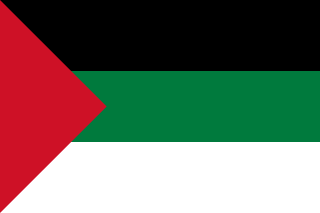
The Hashemite Kingdom of Hejaz was a state in the Hejaz region of Western Asia that included the western portion of the Arabian Peninsula that was ruled by the Hashemite dynasty. It was self-proclaimed as a kingdom in June 1916 during the First World War, to be independent from the Ottoman Empire, on the basis of an alliance with the British Empire to drive the Ottoman Army from the Arabian Peninsula during the Arab Revolt.
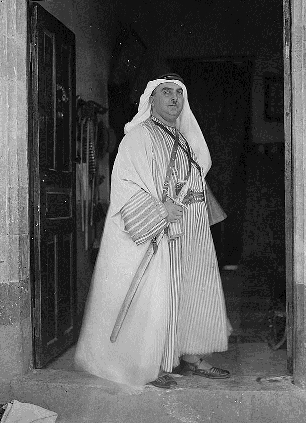
Aref al-Aref was a Palestinian journalist, historian and politician. He served as mayor of East Jerusalem in the 1950s during the Jordanian annexation of the West Bank.
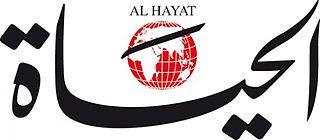
Al-Hayat was a London-based, pan-Arab newspaper owned by Saudi Prince Khalid bin Sultan, that had a circulation estimated over 200,000. It was the newspaper of record for the Arab diaspora and the preferred venue for liberal intellectuals who wished to express themselves to a large public. Founded in 1946, the paper closed in March 2020 after years of financial problems.

The Unification of Saudi Arabia was a military and political campaign in which the various tribes, sheikhdoms, city-states, emirates, and kingdoms of most of the central Arabian Peninsula were conquered by the House of Saud, or Al Saud. Unification started in 1902 and continued until 1932, when the Kingdom of Saudi Arabia was proclaimed under the leadership of Abdulaziz, known in the West as Ibn Saud, creating what is sometimes referred to as the Third Saudi State, to differentiate it from the Emirate of Diriyah, the First Saudi State and the Emirate of Nejd, the Second Saudi State, also House of Saud states.
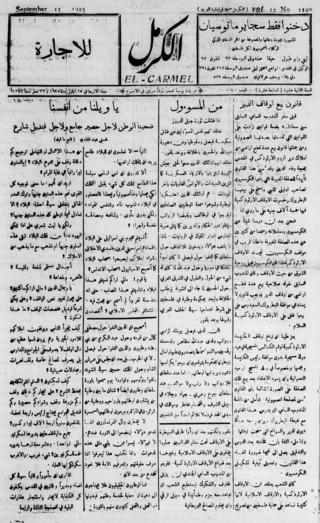
Al-Karmil or El-Carmel was a bi-weekly Arabic-language newspaper founded toward the end of Ottoman imperial rule in Palestine. Named for Mount Carmel in the Haifa district, the first issue was published in December 1908, with the stated purpose of "opposing Zionist colonization".
Al Nadwa was a Mecca-based daily newspaper published in Saudi Arabia. The daily was in circulation until 2013 when it was renamed Makkah.
The Palestine Arab Congress was a series of congresses held by the Palestinian Arab population, organized by a nationwide network of local Muslim-Christian Associations, in the British Mandate of Palestine. Between 1919 and 1928, seven congresses were held in Jerusalem, Jaffa, Haifa and Nablus. Despite broad public support their executive committees were never officially recognised by the British, who claimed they were unrepresentative. After the British defeat of Ottoman forces in 1918, the British established military rule and (later) civil administration of Palestine. The Palestine Arab Congress and its organizers in the Muslim-Christian Associations were formed when the country's Arab population began coordinated opposition to British policies.

Al Anwar was an Arabic daily newspaper published in Beirut, Lebanon. It was founded in 1959 and was one of the leading dailies in Lebanon.

Ma'ruf bin Abdul Ghani al Rusafi was a poet, educationist and literary scholar from Iraq. He is considered by many as a controversial figure in modern Iraqi literature due to his advocacy of freedom and opposition to imperialism and is known as a poet of freedom.
Mir’at al-Sharq, was a Palestinian newspaper published in the British mandate of Palestine during the period between 1919 and 1939.

Khayr al-Dīn al-Ziriklī was a Syrian nationalist and poet in opposition to the French Mandate for Syria and the Lebanon, historian, Syrian citizen and a diplomat in the service of Saudi Arabia.
Umm Al-Qura was the first Arabic language Saudi Arabian daily newspaper based in Mecca, and the official gazette of the Kingdom of Saudi Arabia. The paper has been in circulation since 1924.
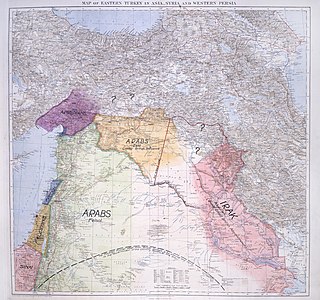
The Sharifian or Sherifian Solution, was an informal name for post-Ottoman British Middle East policy and French Middle East policy of nation-building. As first put forward by T. E. Lawrence in 1918, it was a plan to install the three younger sons of Hussein bin Ali al-Hashimi as heads of state in newly created countries across the Middle East, whereby his second son Abdullah would rule Baghdad and Lower Mesopotamia, his third son Faisal would rule Syria, and his fourth son Zeid would rule Upper Mesopotamia. Hussein himself would not wield any political power in these places, and his first son, Ali would be his successor in Hejaz.
Yusuf Yasin was a Syrian journalist and politician who served in various capacities during the reign of King Abdulaziz and King Saud. He was among the advisers of King Abdulaziz who were employed to improve the decision-making process of the state. Yasin performed several roles in the Saudi government until his death in 1962.
Al Qibla was the official gazette of the Kingdom of Hejaz. The paper was backed by the British. It was in circulation between 1916 and 1924 and headquartered in Mecca. The paper was a four-page broadsheet and published twice a week, on Mondays and on Thursdays.
Al Qabas is the title of two Arabic newspapers both of which were published in Damascus, Syria. The first one was in circulation between 1913 and 1916. The second one was published in the period 1920–1958 with some interruptions.
Al Muqattam was an Arabic newspaper which was published in Cairo, Egypt, between 1888 and 1952. It was one of the leading papers until its closure by the Egyptian government in 1954. The title of the paper was a reference to a range of hills outside Cairo.
References
- 1 2 3 4 5 6 7 8 9 Thomas Aplin (2015). Ambivalence and the National Imaginary: Nation and Canon Formation in the Emergence of the Saudi Novel (PhD thesis). University of Edinburgh. pp. 67–68. hdl:1842/21006.
- ↑ Hala T. Alsudairy (2020). The Role of the Social Media in Empowering Saudi Women's Expression. Newcastle upon Tyne: Cambridge Scholars Publishing. p. 114. ISBN 978-1-5275-5353-8.
- ↑ Ami Ayalon (2010). Reading Palestine: Printing and Literacy, 1900-1948. Austin, TX: University of Texas Press. p. 50. ISBN 978-0-292-78281-5.